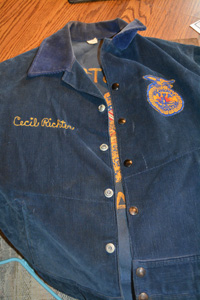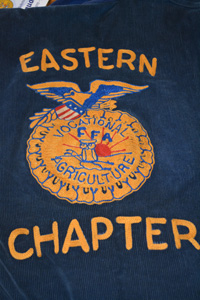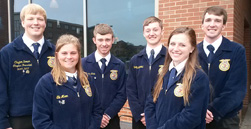SD Agricultural Education and FFA History
The 1940s and World War II impact
December 11, 2017
By Clark W. Hanson
Professor Emeritus, Agricultural Education, SDSU
and Gerri Ann Eide
Executive Director, South Dakota FFA Foundation, Inc.
The past 100 years in agriculture education have resulted in many changes — and many things staying the same. The mission is still to prepare students for successful careers and a lifetime of informed choices in the global agriculture, food, fiber and natural resources systems. Here’s a peak at agriculture education in 1940.
In 1940, the South Dakota FFA Association had 2,138 high school FFA members (nearly 5,000 today), in 1941: 2,400 members. Then World War II affected FFA, like everything else, causing a sharp decline in membership, with only 803 FFA members in 1945. During the war, 50 vocational agriculture departments closed in high schools across the state, due to a lack of instructors.
While the offering of vocational agriculture classes decline during this period of time, South Dakota FFA members were patriotically active by collecting two million pounds of scrap iron, purchasing war bonds totaling $62,000 and planting 550 victory gardens.
Changes made within the National FFA Organization during the war years include:
-
1942 – Membership rules changed so time served in the military would not count in determining membership eligibility.
-
1942 – Due to the war, only 217 delegates and award winners attended the National FFA convention.
-
1944 – National FFA Foundation established.
-
1947 – National FFA Band started
-
1948 – National FFA Chorus started.
-
1948 – National FFA Supply Service started business.
-
1948 – National FFA Week started.
Following the war, teachers were again available and high school farm/shop programs were restarted and improved via the government surplus property program.
Considering this time frame is over 70 years ago, we were fortunate to find a few members who experienced FFA first hand during this era. Author Hanson interviewed Mr. Marvin Haag, current resident of Gettysburg, S.D., who graduated from Parkston, and served as South Dakota FFA president during the war, sharing his FFA experience. He recalls being raised on a farm consisting of two quarters of land, milk cows, chickens, and a few hogs and calves to sell. He describes the time as “pretty tough days.”
Haag was a member of the Parkston FFA, and in 1938 his farm project consisted of a purebred black Poland China sow, with three piglets. He paid $50.00 for the sow. His vocational agriculture teacher was Mr. George Sullivan, from North Dakota and the classroom consisted of tables and chairs, a typical arrangement at that time. Haag recalls being a crops and livestock judging team member. Haag recalls attending the 1941 State FFA Convention and coming out of a meeting having been elected state FFA president. With a chuckle he added, “It must have been my good looks.”
During Marvin’s tenure as state FFA president there was a shortage of gas and for the first and only time the State FFA Convention and judging contests were not held due to the war and the gasoline and tire shortage. Haag did not have the opportunity to preside at his State Convention and completely fulfill his term of office. However, he did attend the National FFA Convention.
In addition, Mr. Duane England, Milbank graduate, shared with author Hanson his personal highs and lows during that time period. England stated he was elected to state FFA office at the 1945 State FFA Convention and was informed a few days later that his older brother had been killed in action in the Europe Theater. Years later, Author Hanson completed his student teaching under England.
In 1946, Congress continued to support vocational agriculture by passing the George-Barden Act, authorizing additional appropriations including funds for the Future Farmers of America.
Author Eide interviewed Cecil Richter, formerly of Madison, S.D. Richter attended Eastern Grade School and High School located on the campus of Eastern State Normal School – now Dakota State University, where he graduated high school in 1947. A phone call after a recent FFA press release connected Richter and Eide originally. Richter called to say he still has his FFA jacket after all these years, lovely kept in the family cedar chest. He put it on, saying, “It doesn’t fit quite like it used to.”
 His jacket is very similar to new FFA jackets today, made of the same FFA blue corduroy now slightly faded, has the clasp on the sides to tighten them up, the button on the sleeves, and his name and an emblem on the front. The back has an emblem, South Dakota and his chapter: “Eastern” embroidered on it. There are a few jacket differences: snaps down the front instead of a zipper, the emblems say vocational agriculture instead of agriculture education; and the emblem on the back is very different, definitely not the machine stitched emblems on today’s jackets. Front and back emblems are actually different from each other. His jacket is very similar to new FFA jackets today, made of the same FFA blue corduroy now slightly faded, has the clasp on the sides to tighten them up, the button on the sleeves, and his name and an emblem on the front. The back has an emblem, South Dakota and his chapter: “Eastern” embroidered on it. There are a few jacket differences: snaps down the front instead of a zipper, the emblems say vocational agriculture instead of agriculture education; and the emblem on the back is very different, definitely not the machine stitched emblems on today’s jackets. Front and back emblems are actually different from each other.
The FFA jacket not only unifies current members in a long-standing tradition and reminds them that they are part of something larger than themselves. It unifies all current and past members in this tradition and serves as an article of faith, honor and pride.
Richter recalls his first year, as a freshman, with one acre of potatoes, which he sold to the local college, and made $125 on the project.  The next 3 years he had 3-4 beef calves that he raised. Since it was during WWII, there was rationing of meat (as well as many other things to deal with). Being industrious, he had the calves butchered and sold the meat to people directly, working around the rationing. He had to keep records for FFA to prove he did what he said. The next 3 years he had 3-4 beef calves that he raised. Since it was during WWII, there was rationing of meat (as well as many other things to deal with). Being industrious, he had the calves butchered and sold the meat to people directly, working around the rationing. He had to keep records for FFA to prove he did what he said.
His instructor was L. J. McCann, who also sold insurance to make ends meet, and later went to Brookings. Classroom curriculum was focused on crops, livestock and weeds. Most shop curriculum was offered at the college – not really part of the FFA. However, he did build bookends and a flower stand in ag class that he still has in his home today.
No real emphasis on fundraisers or service projects. Organizations were not as visible as a whole in the community. No girls enrolled in ag class; they were all in home economics. It was the norm. He doesn’t remember any girls being upset about that.
He attended State FFA Convention and numerous educational seminars in Brookings. He earned his State Farmer Degree and was on the meats judging team. He stated, “I still love meats!” His wife added, “He still goes to the meat counter any time he can, inspects different cuts, and comes home with more meat, even when we don’t need it.”
As a junior, he traveled to the National FFA convention in Kansas City, Missouri, in a Jackrabbit bus. They stayed in the Kansas City Auditorium, with cots down the hallways. He remembers Charlie McCarthy as the main speaker/entertainer with about 1,000 members present.
During the 1949-1950 school year, 54 public schools offered vocational agricultural classes with a total enrollment of 2,099 students. In 1950, the 81st Congress enacted a bill granting a federal charter to the Future Farmers of America including the requirement that a Department of Education staff member be the National FFA advisor.
A South Dakota FFA Foundation program, “Here by the Owl,” provides insight into 1940’s vocational agriculture. It asks former students/FFA members to share their reflections on their high school instructor.
Lyle L. Berg, 1950 graduate of Webster, provides one testimonial. Mr. Berg pays tribute to Ernest Christensen with comments of “exceptional ambition, knowledge of an extremely broad curriculum, devotion towards effectiveness and personal sacrifice for effective learning by students during the school year and on student projects during the summer.”
Some subjects taught and activities lead by Mr. Christensen included: butchering and preparing meat, extemporaneous speaking, storytelling without incorrect reference or words, renting land, buying a new tractor and farming, hosting an annual barbequed beef community event to say Thank you, preparing students for regional and statewide judging competitions, etc.
As you can see the 1940’s had lots of challenges, but many similarities to today’s agriculture education. The next article will focus on the 1950s and the continued growth of vocational agriculture and the South Dakota FFA.
|